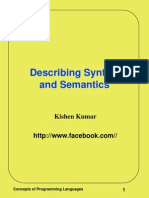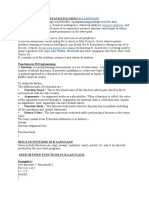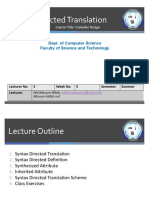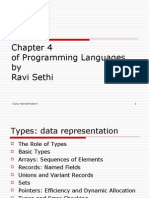Semantics
Uploaded by
Guilherme LimaSemantics
Uploaded by
Guilherme LimaSemantics
Static semantics
attribute grammars
examples
computing attribute values
status
Dynamic semantics
operational semantics
axiomatic semantics
examples
loop invariants
evaluation
denotational semantics
examples
evaluation
(3.1)
Static Semantics
(3.2)
Used to define things about PLs that are
hard or impossible to define with BNF
hard: type compatibility
impossible: declare before use
Can be determined at compile time
hence the term static
Often specified using natural language
descriptions
imprecise
Better approach is to use attribute
grammars
Knuth (1968)
Attribute Grammars
(3.3)
Carry some semantic information along
through parse tree
Useful for
static semantic specification
static semantic checking in compilers
An attribute grammar is a CFG G = (S, N,
T, P) with the additions
for each grammar symbol x there is a set
A(x) of attribute values
each production rule has a set of functions
that define certain attributes of the nonterminals in the rule
each production rule has a (possibly
empty) set of predicates to check for
attribute consistency
valid derivations have predicates true for
each node
Attribute Grammars (continued)
(3.4)
Synthesized attributes
are determined from nodes of children in
parse tree
if X0 -> X1 ... Xn is a rule, then S(X0) =
f(A(X1), ..., A(Xn))
pass semantic information up the tree
Inherited attributes
are determined from parent and siblings
I(Xj) = f(A(X0), ..., A(Xn))
often, just X0 ... Xj-1
siblings to left in parse tree
pass semantic information down the tree
Attribute Grammars (continued)
Intrinsic attributes
synthesized attributes of leaves of
parse tree
determined from outside tree
e.g., symbol table
(3.5)
Attribute Grammars (continued)
(3.6)
Example: expressions of the form id + id
- id's can be either int_type or real_type
- types of the two id's must be the same
- type of the expression must match its
expected type
BNF: <expr> -> <var> + <var>
<var> -> id
Attributes:
actual_type - synthesized for <var> and
<expr>
expected_type - inherited for <expr>
env - inherited for <expr> and <var>
Attribute Grammars (continued)
(3.7)
Think of attributes as variables in the parse
tree, whose values are calculated at compile
time
conceptually, after parse tree is built
Example attributes
actual_type
intrinsic for variables
determined from types of child nodes for <expr>
expected_type
for <expr>, determined by type of variable on
LHS of assignment statement, for example
env
pointer to correct symbol table environment, to
be sure semantic information used is correct set
think of different variable scopes
Attribute Grammars (continued)
(3.8)
Attribute Grammar:
1. syntax rule: <expr> -> <var>[1] + <var>[2]
semantic rules:
<var>[1].env <- <expr>.env
<var>[2].env <- <expr>.env
<expr>.actual_type <<var>[1].actual_type
predicate:
<var>[1].actual_type =
var>[2].actual_type
<expr>.expected_type = <expr>.actual_type
2. syntax rule: <var> -> id
semantic rule:
<var>.actual_type <- lookup
Computing Attribute Values
(3.9)
If all attributes were inherited, could
decorate the tree top-down
If all attributes were synthesized,
could decorate the tree bottom-up
Usually, both kinds are used
use both top-down and bottom-up
approaches
actual determination of order can be
complicated, requiring calculations of
dependency graphs
One order that works for this simple
grammar is on the next slide
Computing Attribute Values (continued)
(3.10)
1. <expr>.env <- inherited from parent
<expr>.expected_type <- inherited from
parent
2. <var>[1].env <- <expr>.env
<var>[2].env <- <expr>.env
3. <var>[1].actual_type <lookup(A,<var>[1].env)
<var>[2].actual_type <- lookup
(B,<var>[2].env)
<var>[1].actual_type =? <var>[2].actual_type
4. <expr>.actual_type <- <var>[1].actual_type
<expr>.actual_type =? <expr>.expected_type
Status of Attribute Grammars
(3.11)
Well-defined, well-understood
formalism
used for several practical compilers
Grammars for real languages can
become very large and cumbersome
and take significant amounts of
computing time to evaluate
Very valuable in a less formal way for
actual compiler construction
Dynamic Semantics
(3.12)
Describe the meaning of PL constructs
No single widely accepted way of
defining
Three approaches used
operational semantics
axiomatic semantics
denotational semantics
All are still in research stage, rather
than practical use
most real compilers use ad-hoc
methods
Operational Semantics
(3.13)
Describe meaning of a program by
executing its statements on a machine
actual or simulated
change of state of machine (values in
memory, registers, etc.) defines
meaning
Could use actual hardware machine
too expensive
Could use a software interpreter
too complicated, because of underlying
machine complexity
not transportable
Operational Semantics (continued)
(3.14)
Most common approach is to use
simulator for simple, idealized (abstract)
machine
build a translator (source code to machine
code of simulated machine)
build a simulator
describe state transformations of
simulated machine for each PL construct
Evaluation
good if used informally
can have circular reasoning, since PL is
being defined in terms of another PL
extremely complex if used formally
VDL description of semantics of PL/I was
several hundred pages long
Axiomatic Semantics
(3.15)
Define meaning of PL construct by effect
on logical assertions about constraints on
program variables
based on predicate calculus
approach comes from program verification
Precondition is an assertion before a PL
statement
states relationships and constraints among
variables before statement is executed
Postcondition is an assertion following a
statement
{P} statement {Q}
Axiomatic Semantics (continued)
Weakest precondition is least
restrictive precondition that will
guarantee postcondition
a := b + 1 {a > 1}
possible precondition: {b > 10}
weakest precondition: {b > 0}
(3.16)
Axiomatic Semantics (continued)
(3.17)
Axiom is a logical statement assumed
to be true
Inference rule is a method of inferring
the truth of one assertion based on
other true assertions
S1, S2, ...,
basic form for inference rule is
Sn
if S1, ..., Sn are true, S is true
S
Axiomatic Semantics (continued)
(3.18)
Then to prove a program
postcondition for program is desired
result
work back through the program
determining preconditions
which are postconditions for preceding
statement
if precondition on first statement is same
as program specification, program is
correct
To define semantics for a PL
define axiom or inference rule for each
statement type in the language
Axiomatic Semantics Examples
(3.19)
An axiom for assignment statements:
{Qx->E} x := E {Q}
Qx->E means evaluate Q with E substituted for X
The Rule of Consequence:
{P} S {Q}, P' => P, Q => Q'
------------------------------------{P'} S {Q'}
(3.20)
Axiomatic Semantics Examples (continued)
An inference rule for sequences
- For a sequence:
{P1} S1 {P2}
{P2} S2 {P3}
the inference rule is:
{P1} S1 {P2}, {P2} S2 {P3}
------------------------------------{P1} S1; S2 {P3}
(3.21)
Axiomatic Semantic Examples (continued)
An inference rule for logical pretest loops
For the loop construct:
{P} while B do S end {Q}
the inference rule is:
(I and B) S {I}
-----------------------------------------{I} while B do S {I and (not B)}
where I is the loop invariant.
Loop Invariant Characteristics
(3.22)
The loop invariant I must meet the
following conditions:
P => I
the loop invariant must be true initially
{I} B {I}
evaluation of the Boolean must not
change the validity of I
{I and B} S {I}
I is not changed by executing the body of
the loop
(I and (notB)) => Q
if I is true and B is false, Q is implied
The loop terminates
this can be difficult to prove
Axiomatic Semantics Evaluation
(3.23)
Developing axioms or inference rules
for all statements in a PL is difficult
Hoare and Wirth failed for function side
effects and goto statements in Pascal
limiting a language to those statements
that can have such rules written is too
restrictive
Good tool for research in program
correctness and reasoning about
programs
Not practically useful (yet) for language
designers and compiler writers
Denotational Semantics
(3.24)
Define meaning by mapping PL elements
onto mathematical objects whose
behavior is rigorously defined
based on recursive function theory
most abstract of the dynamic semantics
approaches
To build a denotational specification for
a language:
define a mathematical object for each
language entity
define a function that maps instances of
the language entities onto instances of
the corresponding mathematical objects
Denotational Semantics (continued)
(3.25)
The meaning of language constructs are
defined by only the values of the
program's variables
in operational semantics the state changes
are defined by coded algorithms
in denotational semantics, they are defined
by rigorous mathematical functions
The state of a program is the values of all
its current variables
Assume VARMAP is a function that, when
given a variable name and a state, returns
the current value of the variable
VARMAP(ij, s) = vj
state s)
(the value of ij in
Denotational Semantics (continued)
(3.26)
Consider some examples
Expressions
Me(E, s):
if VARMAP(i, s) = undef for some i in E
then error
else E, where E is the result of
evaluating E after setting each
variable i in E to VARMAP(i, s)
Assignment Statements
Ma(x:=E, s): if Me(E, s) = error
then error
else s = {<i1,v1>,...,<in,vn>},
where for j = 1, 2, ..., n,
vj= VARMAP(ij, s) if ij <> x
= Me(E, s) if ij = x
Denotational Semantics (continued)
(3.27)
Logical Pretest Loops
Ml(while B do L, s) : if Mb(B, s) = undef
then error
else if Mb(B, s) = false
then s
else if Msl(L, s) = error
then error
else Ml(while B do L,
Msl(L, s))
The meaning of the loop is the value of the program variables
after the
statements in the loop have been executed the prescribed
number of
times, assuming there have been no errors
- if the Boolean B is true, the meaning of the loop (state) is
the
meaning of the loop executed in the state caused by
executing
Denotational Semantics Evaluation
(3.28)
Can be used to prove the correctness of
programs
Provides a rigorous way to think about
programs
Can be an aid to language design
complex descriptions imply complex
language features
Has been used in compiler generation
systems
but not with practical effect
Not useful as descriptive mechanism for
language users
You might also like
- Elements in Mathematics, Economics, Basic Engineering100% (1)Elements in Mathematics, Economics, Basic Engineering1,656 pages
- SCS3008 - Compilers and Automata Theory: Assignment 01No ratings yetSCS3008 - Compilers and Automata Theory: Assignment 014 pages
- Natural Language Processing Parsing Techniques:: Unit IV100% (1)Natural Language Processing Parsing Techniques:: Unit IV24 pages
- Chapter 3 "Describing Syntax and Semantics"No ratings yetChapter 3 "Describing Syntax and Semantics"10 pages
- Compilers and Automata Theory: Assignment 1No ratings yetCompilers and Automata Theory: Assignment 13 pages
- Solving Recurrence Relations Using Machine Learning, With Application To Cost AnalysisNo ratings yetSolving Recurrence Relations Using Machine Learning, With Application To Cost Analysis14 pages
- Grammars: Definitions Grammars Backus-Naur Form DerivationNo ratings yetGrammars: Definitions Grammars Backus-Naur Form Derivation19 pages
- PS1: Introduction and Parser Combinators: Lior Zur-Lotan and Avi Hayoun December 18, 2014No ratings yetPS1: Introduction and Parser Combinators: Lior Zur-Lotan and Avi Hayoun December 18, 20147 pages
- Chapter 4 - Compiler Designnn 1 CompressedNo ratings yetChapter 4 - Compiler Designnn 1 Compressed35 pages
- TORMCA Tool for Regular Model Checking 1st edition by Axel Legay ISBN 3540705437 9783540705437pdf download100% (2)TORMCA Tool for Regular Model Checking 1st edition by Axel Legay ISBN 3540705437 9783540705437pdf download38 pages
- Analysis and Design of Algoritms Wk 1-4No ratings yetAnalysis and Design of Algoritms Wk 1-447 pages
- 1.Backus-Naur Form (BNF) : G= (V,Σ,R,S) ΣNo ratings yet1.Backus-Naur Form (BNF) : G= (V,Σ,R,S) Σ20 pages
- A Provably Time-Efficient Parallel Implementation of Full SpeculationNo ratings yetA Provably Time-Efficient Parallel Implementation of Full Speculation46 pages
- Vietnamese Proper Noun Recognition: Chau Q.Nguyen, Tuoi T.Phan, Tru H.CaoNo ratings yetVietnamese Proper Noun Recognition: Chau Q.Nguyen, Tuoi T.Phan, Tru H.Cao8 pages
- Lab 06 - Python Plus Syntax and Semantics (Answers) PDFNo ratings yetLab 06 - Python Plus Syntax and Semantics (Answers) PDF3 pages
- Run-Time Storage Organization: 66.648 Compiler Design Lecture (03/23/98) Computer Science Rensselaer PolytechnicNo ratings yetRun-Time Storage Organization: 66.648 Compiler Design Lecture (03/23/98) Computer Science Rensselaer Polytechnic16 pages
- Answer Set Based Design of Knowledge SysNo ratings yetAnswer Set Based Design of Knowledge Sys41 pages
- Visvesvaraya Technological University: Artificial Intelligence & Data ScienceNo ratings yetVisvesvaraya Technological University: Artificial Intelligence & Data Science11 pages
- 04_separate_cache_and_path_analysis_(rts00)No ratings yet04_separate_cache_and_path_analysis_(rts00)22 pages
- Using CSP Look-Back Techniques To Solve Real-World SAT InstancesNo ratings yetUsing CSP Look-Back Techniques To Solve Real-World SAT Instances6 pages
- Geometrical Specification Using Dependent Types in PVSNo ratings yetGeometrical Specification Using Dependent Types in PVS20 pages
- Appendix B: Functional Programming With SchemeNo ratings yetAppendix B: Functional Programming With Scheme24 pages
- C. B. Macpherson - The Political Theory of Possessive Individualism - Hobbes To Locke-Oxford University Press (1964)100% (1)C. B. Macpherson - The Political Theory of Possessive Individualism - Hobbes To Locke-Oxford University Press (1964)322 pages
- NCERT Solutions For Class 9 Maths Chapter 5No ratings yetNCERT Solutions For Class 9 Maths Chapter 513 pages
- Meaning: From Parmenides To Wittgenstein: Philosophy As "Footnotes To Parmenides"No ratings yetMeaning: From Parmenides To Wittgenstein: Philosophy As "Footnotes To Parmenides"21 pages
- Discussion Guide-Communication Theory - Racidon P. Bernarte PDFNo ratings yetDiscussion Guide-Communication Theory - Racidon P. Bernarte PDF11 pages
- Basic Gambling Mathematics - The Numbers Behind The Neon by Mark BollmanNo ratings yetBasic Gambling Mathematics - The Numbers Behind The Neon by Mark Bollman323 pages
- Mathematics Subject Classification 1970-2010.msc PDFNo ratings yetMathematics Subject Classification 1970-2010.msc PDF162 pages
- Elliott Mendelson - Foundations Logic, Language and Mathematics100% (2)Elliott Mendelson - Foundations Logic, Language and Mathematics282 pages
- Immediate download Human Goodness Pragmatic Variations on Platonic Themes 1st Edition Paul Schollmeier ebooks 2024100% (3)Immediate download Human Goodness Pragmatic Variations on Platonic Themes 1st Edition Paul Schollmeier ebooks 202471 pages
- Download Complete An Objective Theory of Probability 1st Edition Donald Gillies PDF for All Chapters100% (14)Download Complete An Objective Theory of Probability 1st Edition Donald Gillies PDF for All Chapters60 pages
- Arturo E. Balbastro - Philippine Legal PhilosophyNo ratings yetArturo E. Balbastro - Philippine Legal Philosophy55 pages
- 3Q - M8 - Module 1 - Axiomatic Structure of A Mathematical System in GeometryNo ratings yet3Q - M8 - Module 1 - Axiomatic Structure of A Mathematical System in Geometry13 pages
- Basic Properties of Matter by Dewey B Larson100% (1)Basic Properties of Matter by Dewey B Larson390 pages
- Elements in Mathematics, Economics, Basic EngineeringElements in Mathematics, Economics, Basic Engineering
- SCS3008 - Compilers and Automata Theory: Assignment 01SCS3008 - Compilers and Automata Theory: Assignment 01
- Natural Language Processing Parsing Techniques:: Unit IVNatural Language Processing Parsing Techniques:: Unit IV
- Solving Recurrence Relations Using Machine Learning, With Application To Cost AnalysisSolving Recurrence Relations Using Machine Learning, With Application To Cost Analysis
- Grammars: Definitions Grammars Backus-Naur Form DerivationGrammars: Definitions Grammars Backus-Naur Form Derivation
- PS1: Introduction and Parser Combinators: Lior Zur-Lotan and Avi Hayoun December 18, 2014PS1: Introduction and Parser Combinators: Lior Zur-Lotan and Avi Hayoun December 18, 2014
- TORMCA Tool for Regular Model Checking 1st edition by Axel Legay ISBN 3540705437 9783540705437pdf downloadTORMCA Tool for Regular Model Checking 1st edition by Axel Legay ISBN 3540705437 9783540705437pdf download
- A Provably Time-Efficient Parallel Implementation of Full SpeculationA Provably Time-Efficient Parallel Implementation of Full Speculation
- Vietnamese Proper Noun Recognition: Chau Q.Nguyen, Tuoi T.Phan, Tru H.CaoVietnamese Proper Noun Recognition: Chau Q.Nguyen, Tuoi T.Phan, Tru H.Cao
- Lab 06 - Python Plus Syntax and Semantics (Answers) PDFLab 06 - Python Plus Syntax and Semantics (Answers) PDF
- Run-Time Storage Organization: 66.648 Compiler Design Lecture (03/23/98) Computer Science Rensselaer PolytechnicRun-Time Storage Organization: 66.648 Compiler Design Lecture (03/23/98) Computer Science Rensselaer Polytechnic
- Visvesvaraya Technological University: Artificial Intelligence & Data ScienceVisvesvaraya Technological University: Artificial Intelligence & Data Science
- Using CSP Look-Back Techniques To Solve Real-World SAT InstancesUsing CSP Look-Back Techniques To Solve Real-World SAT Instances
- Geometrical Specification Using Dependent Types in PVSGeometrical Specification Using Dependent Types in PVS
- Cross Correlation: Unlocking Patterns in Computer VisionFrom EverandCross Correlation: Unlocking Patterns in Computer Vision
- C. B. Macpherson - The Political Theory of Possessive Individualism - Hobbes To Locke-Oxford University Press (1964)C. B. Macpherson - The Political Theory of Possessive Individualism - Hobbes To Locke-Oxford University Press (1964)
- Meaning: From Parmenides To Wittgenstein: Philosophy As "Footnotes To Parmenides"Meaning: From Parmenides To Wittgenstein: Philosophy As "Footnotes To Parmenides"
- Discussion Guide-Communication Theory - Racidon P. Bernarte PDFDiscussion Guide-Communication Theory - Racidon P. Bernarte PDF
- Basic Gambling Mathematics - The Numbers Behind The Neon by Mark BollmanBasic Gambling Mathematics - The Numbers Behind The Neon by Mark Bollman
- Mathematics Subject Classification 1970-2010.msc PDFMathematics Subject Classification 1970-2010.msc PDF
- Elliott Mendelson - Foundations Logic, Language and MathematicsElliott Mendelson - Foundations Logic, Language and Mathematics
- Immediate download Human Goodness Pragmatic Variations on Platonic Themes 1st Edition Paul Schollmeier ebooks 2024Immediate download Human Goodness Pragmatic Variations on Platonic Themes 1st Edition Paul Schollmeier ebooks 2024
- Download Complete An Objective Theory of Probability 1st Edition Donald Gillies PDF for All ChaptersDownload Complete An Objective Theory of Probability 1st Edition Donald Gillies PDF for All Chapters
- 3Q - M8 - Module 1 - Axiomatic Structure of A Mathematical System in Geometry3Q - M8 - Module 1 - Axiomatic Structure of A Mathematical System in Geometry




























































































